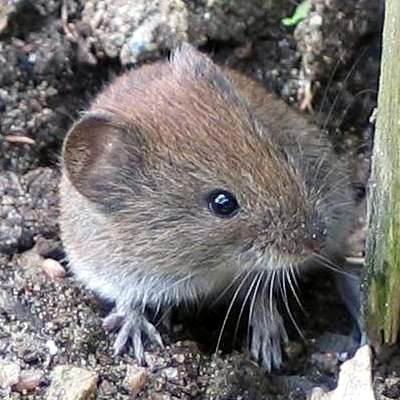It is hard to guess what a Bank vole weights. But we have the answer:
An adult Bank vole (Clethrionomys glareolus) on average weights 20 grams (0.04 lbs).
The Bank vole is from the family Muridae (genus: Clethrionomys). It is usually born with about 1 grams (0 lbs). They can live for up to 4.83 years. When reaching adult age, they grow up to 10.6 cm (0′ 5″). On average, Bank voles can have babies 3 times per year with a litter size of 4.
As a reference: An average human weights in at 62 kg (137 lbs) and reaches an average size of 1.65m (5′ 5″). Humans spend 280 days (40 weeks) in the womb of their mother and reach around 75 years of age.

The bank vole (Myodes glareolus; formerly Clethrionomys glareolus) is a small vole with red-brown fur and some grey patches, with a tail about half as long as its body. A rodent, it lives in woodland areas and is around 100 millimetres (3.9 in) in length. The bank vole is found in much of Europe and in northwestern Asia. It is native to Great Britain but not to Ireland, where it has been accidentally introduced, and has now colonised much of the south and southwest.The bank vole lives in woodland, hedgerows and other dense vegetation such as bracken and bramble. Its underground chamber is lined with moss, feathers and vegetable fibre and contains a store of food. It can live for eighteen months to two years in the wild and over 42 months in captivity and is mostly herbivorous, eating buds, bark, seeds, nuts, leaves and fruits and occasionally insects and other small invertebrates. It readily climbs into scrub and low branches of trees although it is not as versatile as a mouse. It breeds in shallow burrows, the female rearing about four litters of pups during the summer.
Animals of the same family as a Bank vole
We found other animals of the Muridae family:
- Monte gerbil mouse with a weight of 18 grams
- Western red-backed vole with a weight of 18 grams
- Silver mountain vole with a weight of 37 grams
- Van Deusen’s rat with a weight of 67 grams
- Peruvian vesper mouse with a weight of 20 grams
- Stirton’s deer mouse with a weight of 29 grams
- Grey dwarf hamster with a weight of 30 grams
- Brush mouse with a weight of 23 grams
- Sakhalin vole with 7 babies per litter
- Rupp’s mouse with a weight of 48 grams
Animals with the same weight as a Bank vole
As a comparison, here are some other animals that weight as much as the Clethrionomys glareolus:
- One-toothed shrew mouse bringing 21 grams to the scale
- Krebs’s fat mouse bringing 20 grams to the scale
- White-bellied free-tailed bat bringing 21 grams to the scale
- Tufted pygmy squirrel bringing 24 grams to the scale
- Shrew-toothed shrew tenrec bringing 18 grams to the scale
- White-footed mouse bringing 18 grams to the scale
- Eastern false pipistrelle bringing 22 grams to the scale
- Fox’s shrew bringing 21 grams to the scale
- Dobson’s horseshoe bat bringing 19 grams to the scale
- Lesser false vampire bat bringing 24 grams to the scale
Animals with the same size as a Bank vole
Not that size really matters, but it makes things comparable. So here are a couple of animals that are as big as Bank vole:
- Geoffroy’s rousette with a size of 10.7 cm (0′ 5″)
- North African gerbil with a size of 9 cm (0′ 4″)
- Cape golden mole with a size of 10.6 cm (0′ 5″)
- Sandhill dunnart with a size of 10.5 cm (0′ 5″)
- Handley’s slender opossum with a size of 11.3 cm (0′ 5″)
- Ord’s kangaroo rat with a size of 11.4 cm (0′ 5″)
- Cameroon soft-furred mouse with a size of 11.5 cm (0′ 5″)
- Northwestern deer mouse with a size of 9.3 cm (0′ 4″)
- Tarabundí vole with a size of 12.1 cm (0′ 5″)
- Sagebrush vole with a size of 10.3 cm (0′ 5″)
Animals with the same litter size as a Bank vole
Here is a list of animals that have the same number of babies per litter (4) as a Bank vole:
- Black-tailed prairie dog
- Dice’s cottontail
- Short-tailed shrew tenrec
- Turkestan rat
- New Holland mouse
- Eastern cottontail
- Desert pocket gopher
- Visayan warty pig
- Sandstone false antechinus
- New England cottontail
Animals with the same life expectancy as a Bank vole
Completely different animals, but becoming as old as a Bank vole:
- Peters’s climbing rat with an average maximal age of 5.33 years
- Saharan striped polecat with an average maximal age of 5 years
- Val’s gundi with an average maximal age of 5 years
- Sundevall’s jird with an average maximal age of 5.58 years
- Woodland jumping mouse with an average maximal age of 4 years
- Aders’s duiker with an average maximal age of 4 years
- Little free-tailed bat with an average maximal age of 5 years
- Hairy-tailed mole with an average maximal age of 5 years
- Wood mouse with an average maximal age of 4.33 years
- Brush-tailed phascogale with an average maximal age of 5 years
